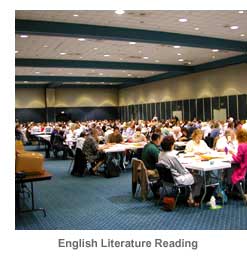
If you’re studying for an AP exam right now or are thinking about taking an AP class in the future, you might be wondering: how are AP exams scored?
In this post, we'll break down the scoring process, all the way from the raw scores you earn on the multiple-choice section and essays to how you get a final score on a scale of 1-5. Knowing how AP exams are scored can help you do your best on them—especially if you want a perfect 5!
The AP Scoring Scale
Each AP test is given a score from 1 to 5. According to the College Board (the group that administers AP tests), these numbers translate in the following ways:
- 5: Extremely Well Qualified
- 4: Well Qualified
- 3: Qualified
- 2: Possibly Qualified
- 1: No recommendation
Any score that's 3 or higher is considered a passing score, though some colleges only accept 4s and 5s for credit. (See AP’s college database for specific policies at each university.) Getting a 5 is especially desirable because, for most exams, it puts you in the top 10-20% of scorers. See our list of AP classes for more info on passing rates.
Your 1-5 score is a scaled score, converted from a composite score. Your composite score is calculated from the total number of raw points you earned from your correct multiple-choice answers and your free response. It’s a bit confusing, but we will guide you through the process!
How Are AP Tests Scored?
The majority of AP exams consist of two sections: multiple choice and free response. On some exams each section is weighted equally, whereas on others one section is worth slightly more. You can look up the specifics for each exam on the official AP courses pages.
The multiple-choice section is graded by a computer. There are no deductions for incorrect or blank answers, so your raw multiple-choice score is simply the number of questions you get correct.
The free-response section is graded during the annual AP Reading held in the first two weeks of June. The AP Reading is basically a huge convention. Tons of teachers and college professors gather to grade thousands and thousands of student-written responses for each exam.
This is why you don't get your AP scores until July even though you take the test in May: the written portion of your exam isn't graded until mid-June.
After that, the College Board has to calculate the composite score and final scaled score for each exam, equating the test so the scores stay even from year to year. (For example, they want to make sure a 3 on the AP US History exam means the same thing from one year to another, even if one version of the test turned out to be more difficult for students.)
(Side note: There is a good chance that an AP teacher at your school goes to the AP Reading each year. It can be interesting and helpful to talk to them about what happens at the convention, how quickly free responses are scored, and the best and worse free responses they’ve seen. These are answers that will vary a lot from subject to subject but could ultimately be helpful to you!)

This is a picture from the English Literature Reading from this blog post over at AP Central. It's worth taking a look at if you are curious about what the AP Reading is like!
Each free response is given a "holistic" score, meaning it's evaluated for its overall effectiveness or correctness. Typically, points aren’t deducted for the occasional small error, such as a spelling or grammar mistake. Most tests grade their free responses between 1 and 9, with 1 being least effective and 9 being nearly perfect.
Your raw free-response score is the total of the scores you get for each response.
How to Get a Scaled AP Score Between 1 and 5
After your multiple-choice section is graded by a machine and your free response is graded by a human, your essay and multiple-choice scores are combined to give you a composite score. This score is just a way of combining the two section scores so that they are weighted correctly. For example, for AP English, multiple choice is worth 45% and free response is worth 55%. Often, composite scores are between 0 and 100, or 0 and 150.
The composite score is then converted to a number on the scaled score range 1-5. This means that for each scaled score, there is a range of possible composite scores that could earn it. For example, a 5 could be any composite score between 110 and 150 on one exam.
Since scaling varies year to year, there are no exact cutoff numbers for scores for AP tests, and the College Board does not release detailed scoring data. Furthermore, you will not see what your composite score was on your AP score report—you'll only get the final number between 1 and 5.
However, many teachers, prep books, and websites have come up with formulas to predict the scaled score for each AP test, which can help when you are grading your practice tests and trying to come up with a target score.
Scoring Example: AP English Language and Composition
As we've seen, AP test scoring is not exactly straightforward. To help clarify the process, we will walk through a scoring example using the most popular test, AP English Language and Composition.

Also known as the class in which you annotate every. Single. Thing.
Here are the basics of the AP English exam: it has 55 multiple-choice questions, worth 45% of your score, and three essays, worth 55% of your score. Each essay is graded between 1 and 9.
Before we get into the scoring example, remember that this guide is an estimation since score conversions can vary year to year based on test difficulty. While it's impossible to precisely predict an AP test score before you get your score, you can still get an idea of how the process works.
Step 1: Add Up Your Correct Answers to Get Your Raw Scores
There are 55 multiple-choice questions on the AP English exam. Let's say you get 40 right, get eight wrong, and leave seven blank. Your raw multiple-choice score would be an even 40 points.
Out of the three essays, let's say you earn the following scores from the graders: 4, 7, and 8. This gives you a total raw essay score of 19 (4+7+8).
Step 2: Convert Your Raw Scores to a Single Composite Score
Now, this is the tricky part in which we will convert each of those raw scores to a single composite score between 0 and 150.
The maximum converted essay score is 82.5, or 55% of 150. The maximum converted multiple-choice score is 67.5, or 45% of 150. To figure out your composite score, use this formula:
(Multiple Choice Raw Score x 1.23) + (Essay Raw Score x 3.05) = Composite Score
In this example, your multiple-choice composite score would be 49.2, and your essay composite score would be 57.95. Thus, your total composite score would be 107 (rounded down).
Step 3: Use the Chart to Estimate Your Scaled Score
The last step is easy. Use the chart below to estimate your final AP score (on a scale of 1-5):
| Composite Score (0-100 or 0-150) | Scaled Score (1-5) |
| 104-150 | 5 |
| 92-103 | 4 |
| 76-91 | 3 |
| 50-75 | 2 |
| 0-49 | 1 |
As you can see, your score of 107 would earn you a 5—but just barely!
Again, these numbers are estimates and will shift from year to year based on test difficulty. Since 107 is just over the mark of 104, it's possible that in some years it could net you a 4 instead of a 5.
What About Scoring Other AP Tests?
We’ve learned how to score an AP English Language and Composition exam. However, you can’t use this exact same process for every AP test. Most AP tests have slightly different section weights and question totals, so the scoring formulas are different.
For example, AP Calculus AB has fewer multiple choice questions (45), more free responses (six total), and weighs each section at 50%.

Each AP subject is a unique challenge ... and has its own scoring formula.
So how can you figure out how the AP tests you are taking are graded?
First, if you’re taking the AP class for the test you want to take, ask your teacher if he or she has a formula for converting practice test scores to scaled scores. Most AP teachers have a formula they use with their students for practice exams.
If you’re not taking the class or your teacher doesn’t have a formula, either find a prep book for your specific test or search online.
Remember that all formulas are estimates. So if you really want a 5, you shouldn’t aim for the lowest possible composite—you should aim for perfection, or very close. That’s the only way to guarantee you'll get a 5 on test day.
On the other hand, if you just want to make sure you pass, try to aim for a 4 so that even if you make more mistakes than you're hoping to, you’ll still get at least a 3!
What’s Next?
Curious about the benefits of taking an AP Exam? See our in-depth guide about what AP tests are and why you should take them.
Also studying for the SAT? Get tips from our resident 1600 full scorer, and check out how to improve a low SAT Math score.
Studying for the ACT instead? Get tips on the essay, read a guide to the daily ACT question, and learn how you can score a perfect 36.












